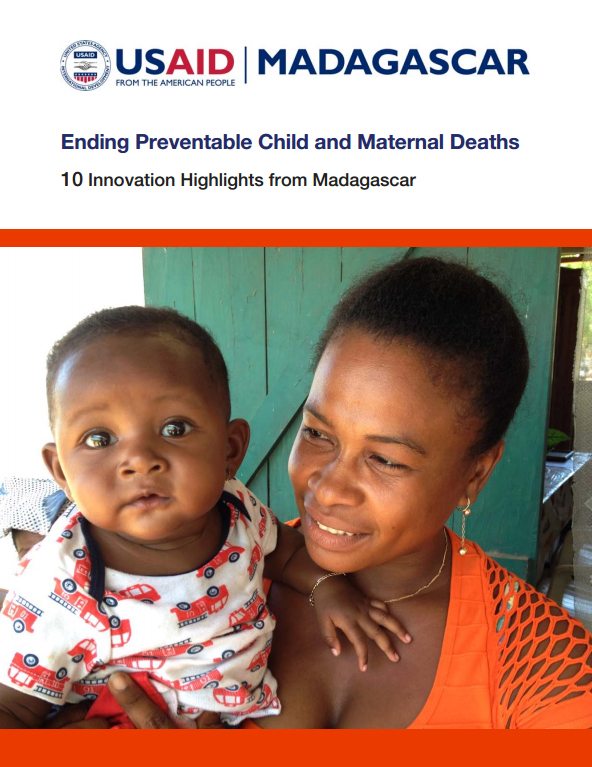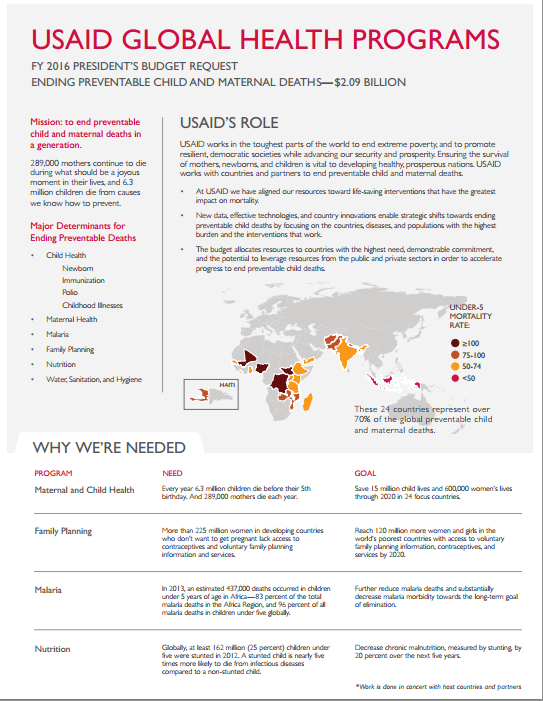Ending Preventable Child and Maternal Deaths ![]() (pdf - 4 MB)
(pdf - 4 MB)
Every day, 100 Malagasy children die- primarily from common and preventable illnesses. And, every day 10 Malagasy women die from complications related to pregnancy and childbirth. Ending preventable child and maternal deaths is a priority for the United States Agency for International Development (USAID). To this end, USAID/Madagascar is fully committed to deliver high-impact, evidence-based maternal, newborn and child survival interventions that address the primary causes of mortality on a meaningful scale. To further our impact, USAID/Madagascar is actively advancing the USAID Forward agenda to identify and scale-up innovative breakthrough solutions to intractable development challenges.
For more than 20 years USAID has been a leading supporter of child health and nutrition programs in Madagascar. In recent years, the primary focus has been on increasing access to maternal and child health, including malaria and family planning services and products with a focus on rural and remote communities.
Madagascar has made significant progress towards reducing child, newborn and infant mortality over the past 15 years. Under-five child mortality reached 52 per 1,000 live births in 2013, surpassing the Millennium Development Goals (MDG) target of 56 by 2015.
More than 20 percent of under-five mortality in Madagascar is due to pneumonia—the single leading cause of child death, followed by diarrhea, malaria and other nutrition-related factors. Additionally, more than half of the country’s population lives more than 5km from a health center, making it difficult for a skilled health provider to attend to all births and for pregnant women to deliver at a health facility. And even when pregnant women manage to visit the nearest health facility, the quality of care is an issue.
USAID/Madagascar has adopted new and innovative approaches ‘to reduce child mortality, improve maternal health, and achieve universal access to reproductive health’ (4th and 5th MDGs). One such innovative approach is the support it provides to an expanded network of over 17,000 CHVs in nearly all the 22 regions of Madagascar, with skills training, job aids, and life-saving health commodities. This program increases access to life-saving products and services to the majority population living in the rural and remote countryside.
USAID Global Health Programs ![]() (pdf - 1 MB)
(pdf - 1 MB)
Other innovations include the community-led total sanitation (CLTS), which is an innovative hygiene behavior change methodology for the communities to eliminate open defecation; support to the use of Chlorhexidine (CHX), a low cost antiseptic that provides effective protection against umbilical cord infection in the newborn; preventing premature births, which is a leading cause of deaths in the newborn; provision of pregnancy test kits; use of Misoprostol to prevent hemorrhage after childbirth; emergency transport systems, etc.
These are some of USAID/Madagascar’s current efforts to address the primary causes of mortality. USAID is investing in maternal, newborn and child health as well as malaria and family planning, with a view to identifying new ways to strengthen the impact of our partnership.
Community Level Risk Factors for Maternal Mortality in Madagascar (pdf, 153kb)
Madagascar: Countdown to 2015 (pdf, 392kb)
Madagascar: acting on the call (pdf, 488kb)










Comment
Make a general inquiry or suggest an improvement.